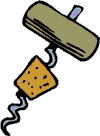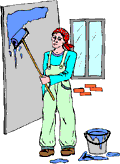Wise One,
We have a conundrum. Our house is covered with cedar shingles, which some dope painted, presumably with toxic or lead-laden paint. The paint is flaking, and we need to either get rid of it completely or treat the flakes and paint over them. What is the least toxic (to our family and home environment), affordable way to either strip or repaint?
Thanks,
John
Missoula, Mont.
P.S. Bonus: Is there any reason not to put wine corks in our compost? Thinking about my toxic home seems to generate lots of corks.
Dearest John,

My job seems to generate a lot of corks as well, so I’ll answer your bonus question first: Those new-fangled plastic corks will never degrade in your compost, and even the old-school ones are quite durable. Chopping them into little bits might aid decomposition. And if you chop them small enough, they will at least be a nice soil aerator. I’m of the try-it-and-see school of composting, so please report back.
We can’t be so cavalier about the paint, unfortunately. If your house was first painted after 1978, the year lead-based paint was banned in the U.S., you are in the clear for lead poisoning. In that case, have some good housepainters look at your house and tell you what the painting or stripping opportunities are. Once you’ve chosen a method, you can hire them or do it yourself.
If you are not sure whether any paint was applied prior to 1978, get your home tested. The U.S. EPA recommends using trained professionals, not home test kits. You can get a list of trained inspectors by calling 1.888.LEADLIST. How on Earth do I know that number? From my little pamphlet, “Reducing Lead Hazards When Remodeling Your Home,” aka EPA Office of Pollution Prevention and Toxics Publication 747-K-97-001. If the inspector tells you that you have lead paint but seems unable to tell you what to do about it, call the EPA (1.800.490.9198) and ask them to send you all their lead-related publications for homeowners. You can also download them from the EPA website, but you have to navigate the cyberspace equivalent of a mammoth bureaucracy to do so.

Painting the town lead.
Now, it’s time for me to come clean: I have all the EPA’s pamphlets because once upon a time, before I lived down here in the Hardcover and Periodicals Unit (floors 2B-4B), I set out to paint an old house and felt a little nervous about it. After reading the pamphlets, I switched from feeling nervous to feeling overwhelmed, followed only some of their recommendations, and then spent a long time rationalizing my laziness.
That was Bad. It is very important that you educate yourself about the hazards of lead and follow the guidelines of the EPA (as opposed to my own poor example). Lead poisoning affects children’s developing nervous systems (i.e., reduces brain function) and makes adults sick and depressed. It is such a serious environmental and health hazard that even the federal government no longer equivocates about its devastating effects. Precautions should be followed, especially when repainting the exterior of an older house. In addition to wearing a mask, and covering every inch of your skin, you should rent an HVAC vacuum and cover the sides of the house with plastic sheeting.
If your house is coated with lead paint, you will need to make an educated decision about how best to safeguard your family’s health and avoid poisoning the soil for all eternity. You can scrape and paint the house yourself, following all the EPA guidelines, or you can hire a trained and equipped crew. The decision you make will be based on your budget and commitment. I’m glad you raised the issue, though, since I’ll need to paint these boring gray stacks sometime soon, and I needed to redouble my commitment to my own health. If I’m going to get any dumber, I’d rather it was from too many corks than too much lead.
Leadenly,
Umbra


